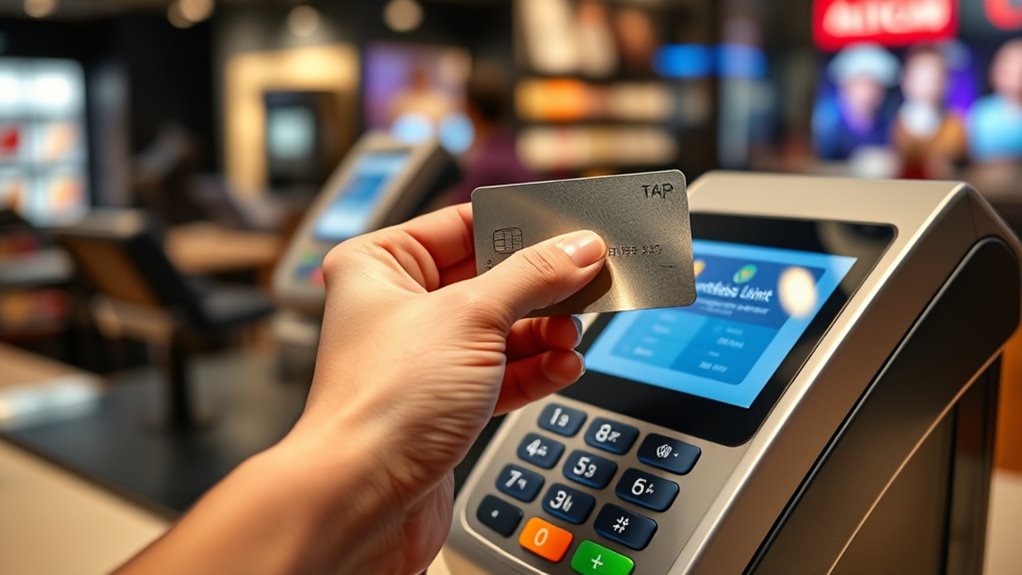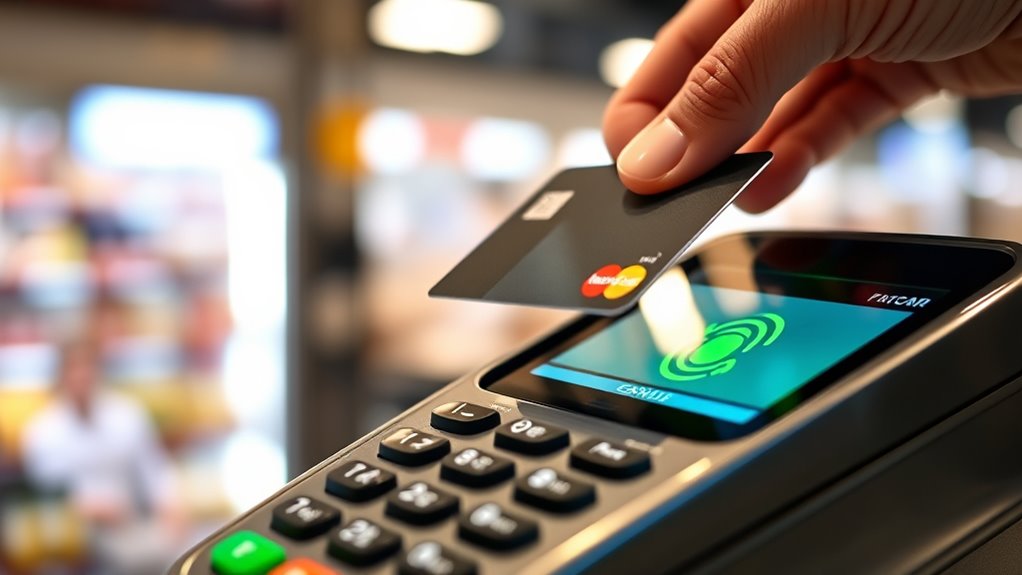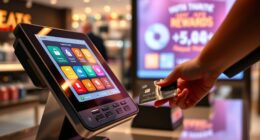As contactless limits rise, issuers consider factors like evolving consumer habits, security protocols, and technology advances. They analyze transaction data to understand spending patterns and assess risks, ensuring safeguards like multi-factor authentication and encryption are in place. Enhanced security enables higher thresholds while protecting your payments. If you want to learn how these decisions balance speed and safety, keep exploring the latest developments shaping contactless payments today.
Key Takeaways
- Issuers analyze consumer transaction data, including average spending and frequency, to determine appropriate contactless payment limits.
- Security advancements like biometric authentication and dynamic data enable safe increases in contactless thresholds.
- Technological innovations and encryption methods allow issuers to confidently raise limits while maintaining security.
- External factors such as increased contactless usage during COVID-19 influence issuer decisions on threshold adjustments.
- Ongoing assessment of fraud risks and consumer behavior guides issuers in setting and updating contactless payment limits.

Have you noticed your contactless payment limits increasing lately? It’s no coincidence. Financial institutions and card issuers are adjusting these thresholds to keep up with evolving consumer habits and technological advancements. As contactless payments become more common, the way issuers decide these limits involves a careful balance of security protocols and customer convenience. They want to make transactions quick and easy but also safe from fraud and unauthorized use. That’s why you might see higher limits now—these changes are driven by a combination of improved security measures and the way people prefer to pay. Modern contactless technology uses dynamic data, making it difficult for hackers to duplicate or intercept payment info. Because of these advancements, issuers are more comfortable raising limits without substantially increasing risk. They also implement safeguards such as transaction alerts and multi-factor authentication for larger payments, which reassures both the issuer and you that your money stays protected. Additionally, as security protocols evolve, issuers can confidently increase contactless limits while maintaining high standards of safety. They also analyze payment technology to better understand how consumers utilize contactless options and adjust limits accordingly. They may also incorporate insights from bank SWIFT/BIC codes to ensure seamless international transactions. Consumer habits considerably influence how these limits are set. Over the past few years, you’ve probably shifted from cash to cards and mobile wallets for everyday purchases. Retailers and consumers now favor quick, contactless transactions, especially for small to medium-sized expenses. This shift in behavior prompts issuers to reassess the thresholds to accommodate the way people want to pay. Higher contactless limits mean fewer interruptions at checkout, less need to insert or swipe cards, and a smoother shopping experience. Additionally, during the COVID-19 pandemic, contactless payments gained popularity since they reduce physical contact, further encouraging issuers to increase limits to match the new norm. Issuers also analyze transaction data to identify patterns and risks. They consider factors like average transaction size, frequency of contactless use, and geographic location. If data shows that consumers frequently make larger, routine payments contactlessly, issuers are more likely to raise limits accordingly. Conversely, if there’s a spike in fraud or suspicious activity, limits may be tightened temporarily. This dynamic approach helps issuers strike a balance between convenience and security, adapting to changing consumer habits and technological shifts. They also leverage biometric authentication to enhance security, allowing for higher limits with added protection. Furthermore, the integration of advanced encryption methods provides an additional layer of safety, making higher contactless limits more feasible. Ultimately, the rising contactless limits reflect a strategic effort to meet your needs for faster, safer transactions. As technology advances and your habits evolve, issuers continuously adjust their security protocols and thresholds. They aim to provide a seamless payment experience that aligns with your expectations while safeguarding your financial information. So, the next time you see your contactless limit increase, you’ll know it’s a thoughtful response to both technological progress and your changing payment preferences.
Frequently Asked Questions
How Do Contactless Payment Limits Vary Across Countries?
You’ll notice that contactless payment limits vary across countries due to regional differences and cultural factors. In some places, limits are higher to promote convenience and faster transactions, while others keep them lower for security reasons. These variations reflect local banking regulations, consumer habits, and trust levels. Understanding these differences helps you navigate international transactions smoothly, recognizing that each country tailors contactless limits to suit its unique economic and cultural landscape.
What Security Measures Are in Place for Higher Contactless Limits?
Imagine stepping into a future where your contactless payments can go higher. To keep your money safe, issuers use advanced security measures like biometric authentication and tokenization security. These tech-savvy safeguards verify your identity quickly and protect your card info from fraud. So, even as limits rise, you can trust that your transactions stay secure, just like a trusted knight guarding your digital treasure.
Can Consumers Set Their Own Contactless Transaction Limits?
You can’t typically set your own contactless transaction limits directly. However, some banks offer personal limit customization or user control options through their mobile apps or online banking. These features allow you to adjust your contactless spending cap within certain safety parameters. Check with your issuer to see if they provide such control options, so you can manage your contactless transactions according to your comfort level.
How Do Merchants Ensure Compliance With New Contactless Thresholds?
You need to stay ahead of the game when it comes to contactless thresholds. Merchants guarantee compliance by conducting thorough training, so staff understands new limits. They also use compliance monitoring tools to spot any issues early on. This way, they keep transactions smooth and avoid issues that could cause a ripple effect. Staying vigilant and proactive helps merchants stick to regulations and protect both their business and customers.
Are There Specific Card Types Eligible for Increased Contactless Limits?
You should check your card’s eligibility, as not all card types qualify for increased contactless limits. Issuers set limit adjustment policies based on the card type, security features, and transaction history. Typically, contactless cards issued by major banks or those with specific security standards are eligible for higher thresholds. Always verify with your issuer, since card eligibility varies and limits are adjusted according to their policies.
Conclusion
As contactless payment limits increase, you’ll find it even easier to make quick, secure transactions. Did you know that over 60% of consumers prefer contactless payments for their convenience? This rising threshold shows how issuers are adapting to meet your needs while maintaining security. So, next time you tap your card or phone, remember that these limits are designed to keep your transactions smooth and safe—making your everyday payments faster than ever.










